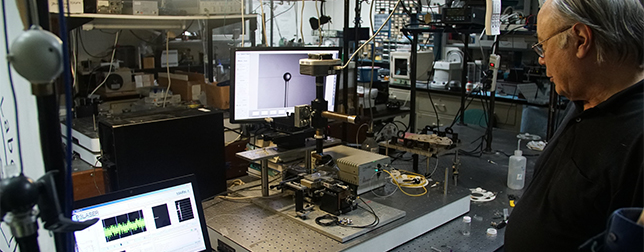University Professor of Applied Physics Stephen Arnold and his team at the New York University Tandon School of Engineering have made a discovery that could lead to Star Trek-like biosensor devices capable of flagging the barest presence in blood of a specific virus or antibody, or protein marker for a specific cancer; or sniffing out airborne chemical warfare agents while they are still far below toxic levels.
The discovery follows years of groundbreaking work by Arnold, who in 1995 discovered that an optical fiber could excite what he termed Whispering Gallery Mode (WGM) in polymer micro-beads less than one-third the diameter of a human hair. Further discoveries and patents led to WGM biosensors capable of gauging the mass of viruses, proteins and other nanoparticles by sending them into spacecraft-like orbit around the micro-bead, thanks to a photonic “tractor beam” caused by the resonating light. Arnold and collaborators then devised a way to make these WGM biosensors sensitive enough to identify even the smallest individual bio-particles from the RNA virus MS2 to single molecules down to 6 zepto-grams (a thousandth of a billionth of a billionth of a gram), below the mass of all known cancer markers. Many companies, including Genalyte, employ WGM biosensors in diagnostic products that can perform dozens of bioassays in minutes.
Now, Arnold and his team at NYU Tandon’s MicroParticle PhotoPhysics Laboratory for BioPhotonics are the first to find a way to determine the density of charges on an area of a WGM micro-bead’s surface, as well as the charge of an ensnared nanoparticle or virus, by measuring how light frequency fluctuates as the tiny particle follows its wobbly course around the sphere. This discovery could allow researchers and manufacturers not just to identify nanoparticles, but to manipulate them.
The WGM biosensor, which Arnold named for the famous Whispering Gallery in the dome of St. Paul’s Cathedral in London, is a device the size of a small smartphone comprising a tunable laser guided down a specially treated fiber optic filament with a detector at the far end of the filament measuring the light’s intensity and resonance. A tiny silica bead next to the filament diverts a portion of the light beam, which begins to resonate within the bead the way sound resonates under the dome of the church gallery for which the phenomenon is named.
While the WGM biosensor’s ability to identify individual nanoparticles led to highly sensitive measuring capabilities, Arnold’s latest discovery could make possible biosensors tailored to very specific applications, from wearable sensors for soldiers and rescuers designed to detect extremely low concentrations of a suspected airborne nerve agent, to ways of increasing the efficiency of nanoparticle drug uptake and redistribution.












